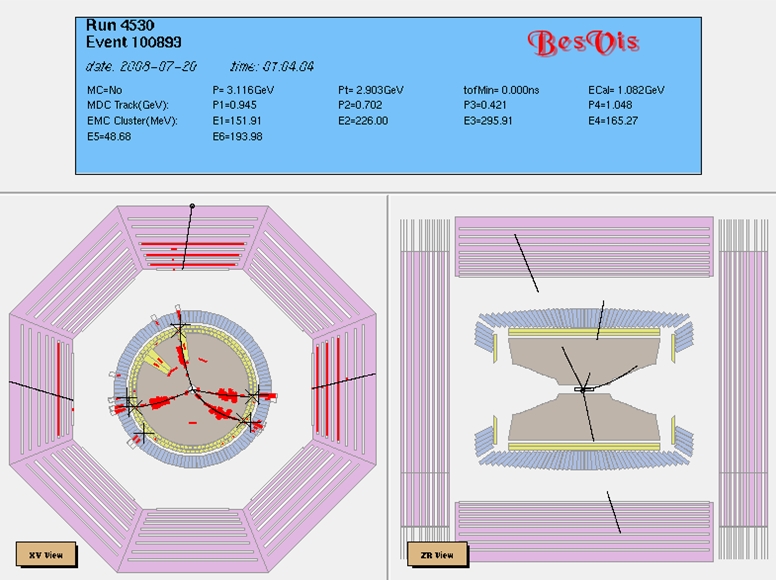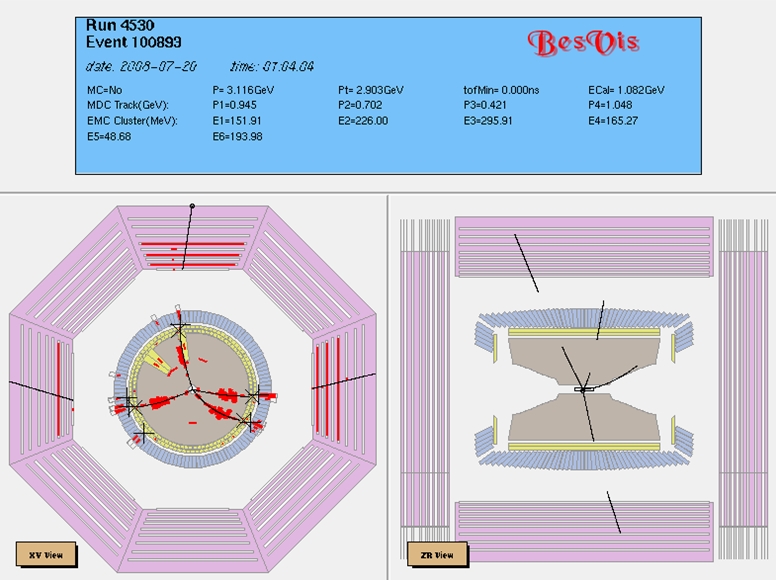BEPC & BEPCII
First e+e- Collison at BEPCII/BESIII
When it is fully operational, the BEPCII/BESIII complex will be the world’s premier facility for studying the properties of particles that contain a charmed quark (c-quark), the fourth of an assortment of six different quarks that physicists have identified as the most fundamental building blocks of matter. In BEPCII, c-quarks, which have a mass that is about 3000 times that of the electron, are produced together with their equal-mass antimatter counterpart, anti-charmed quarks (c-quarks), in head-on collisions of high energy electrons and anti-electrons (familiarly known as positrons). In these collisions, the electron and positron annihilate each other and in the process their energy is converted into the massive c- and c-quark pair in accordance with Einstein’s famous relation E=mc2.
To accomplish this, the BEPCII team confines a tightly bunched cluster of approximately 50 billion electrons inside a vacuum tube that threads through a ring of powerful electro-magnets that maintains the electron bunch in a nearly circular orbit. Likewise a similar “bunch” of positrons is made to counter-rotate in an identical second ring of magnets. The two bunches, which have a vertical profile of only about five millionths of a meter, are made to cross each other in the center of the BESIII detector. Occasionally, an electron in one bunch hits a positron in the other bunch head-on and the two particles annihilate each other to produce a pair of particles: one containing a c-quark and an associated one that contains a c-quark. These so-called charmed particles rapidly decay into more conventional particles like p- and K-mesons whose energies and velocities are precisely measured in the BESIII spectrometer. From these measurements, the properties of the parent charmed particles can be deduced.
BEPCII is a major upgrade of IHEP’s previous collider BEPC. The major change has been the addition of a second ring of magnets that allows the electron and positron beams to be stored separately. In BEPC, the electrons and positrons shared the same vacuum tube in a single ring of magnets, and this arrangement could accommodate only a single bunch each of electrons and positrons, thereby limiting the rate at which interesting particles are produced. The two separate rings of BEPCII will allow for 93 bunches in each ring. In addition, BEPCII has many other improvements including a more powerful injection accelerator that produces the high energy electrons and positrons, and an extensive use of superconducting technology, both for the acceleration and magnetic focusing of the stored electron and positron beams. The net effect of all of these improvements will be a more than hundredfold increase in the collision rate.
The BESIII detector is completely new with a number of major improvements over its predecessor, BES-II. These include its huge superconducting magnet, which produces a magnetic field throughout the detector that is about 20,000 times stronger than the Earth’s magnetic field. This strong magnetic field deflects charged particles as they traverse the detector and by measuring the amount of deflection researchers can make precision measurements of the particles’ velocities. This magnet, which is the most powerful magnet in China, was built at IHEP by the laboratory’s research staff. In addition, BESIII contains a large array of 6240 crystals of Cesium Iodide that are used to measure the energies of the high-energy gamma rays that are produced in the collisions. The combination of the superconducting magnet and the large crystal array enables the BESIII detector to measure the energies and velocities of the produced particles with more than ten times better precision than was previously possible with BES-II. To handle the huge data rates expected in the BESIII detector, a specialized state-of-the-art high speed data communication system has been developed and implemented.
BEPCII’s double ring system was completed in Oct. 2006, beams were first stored during the following month and first collisions were produced in March 2007. . The assembly of the BESIII detector was completed in January of this year, and it was moved into the interaction region in early April (see Fig. 1).

Fig. 1 The BESIII detector in the interaction region of BEPCII
In last weekend’s initial test run, a pair of charmed particles, where one contains a c- quark and the other a c-quark was recorded in the detector approximately every ten minutes. A display of one of the first such events is shown in Fig. 2. The collision rate in the initial test run was about a factor of 4,000 times slower that the project’s ultimate design goal of 6 or 7 charmed-particle pairs per second. This lower rate was partly because the researchers purposely limited the intensity of the electron and positron beams in order to avoid possible damage to the very sensitive detection sensors of the BESIII spectrometer while they made sure that everything is working as expected. The next day, intensities were increased and a ten-times higher collision rate was measured. Over the next several weeks the intensity of the beams will gradually be further increased while at the same time BESIII’s nearly 20,000 detection elements will be carefully adjusted and calibrated. When this process is completed, sometime in the early Fall, the BESIII research program will begin.


Fig. 2 The first charmed-meson pair event seen in BESIII.
Recently, researchers working at IHEP and at laboratories in Japan and the U.S. have observed a number of interesting and unexpected properties of charmed particles that will be investigated with unique sensitivity with BESIII; these observations have added substantially to the world-wide particle physics community’s interest in the BESIII research program. These new developments include the surprising observation that neutral charmed mesons, i.e., mesons containing a c-quark and an anti-up quark (u-quark), spontaneously transform into anti-charmed mesons (i.e., u- and c-quark mesons) and vice versa, a phenomenon that was quite unexpected. BESIII will be uniquely able to perform important measurements that categorize this process to help theoretical physicists understand the root cause for these transformations. Recently, there have been hints that inside so-called Ds mesons, which are particles comprised of a c-quark and an anti-strange quark (s-quark), the constituent c- and s-quarks annihilate each other at a rate that seems to be higher than that predicted by theory. If this discrepancy could be unequivocally established, which is something that BESIII is particularly well suited to do, this would be striking evidence for a whole new regime of forces and associated particles in nature. In addition, the BESII experiment at IHEP and a number of experiments at other laboratories have uncovered a new class of particles that do not fit into the conventional quark model scheme. To date, in spite of considerable effort, theorists have been unable to achieve a compelling picture that describes these states. More detailed measurements are necessary, and this is something that BESIII will do.
It is estimated that these and the many other topics to be investigated by BESIII correspond to an approximately ten-year-long program of intensive research. This research will be carried out by an international team of researchers from China, Hong Kong China, Germany, Japan, Russia and the U.S. Sunday’s observation of first collisions in the BEPCII/BESIII facility was an important milestone in this research program.